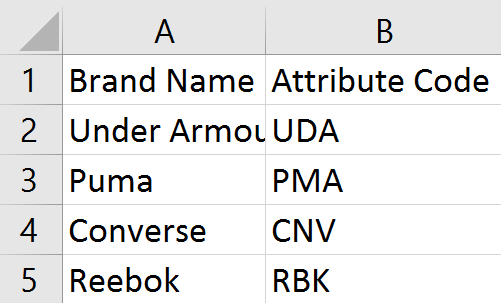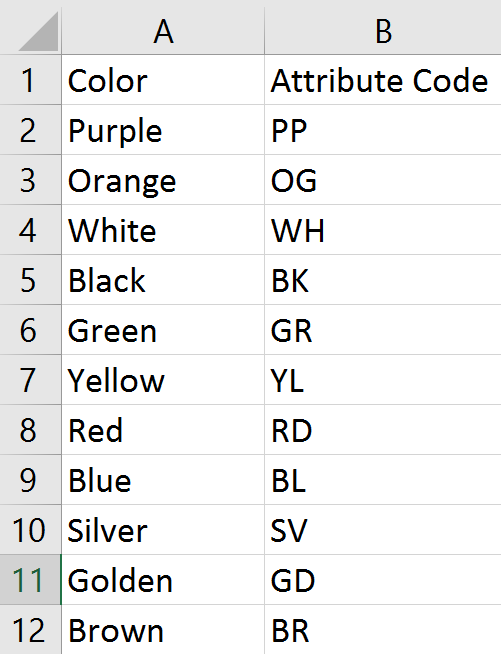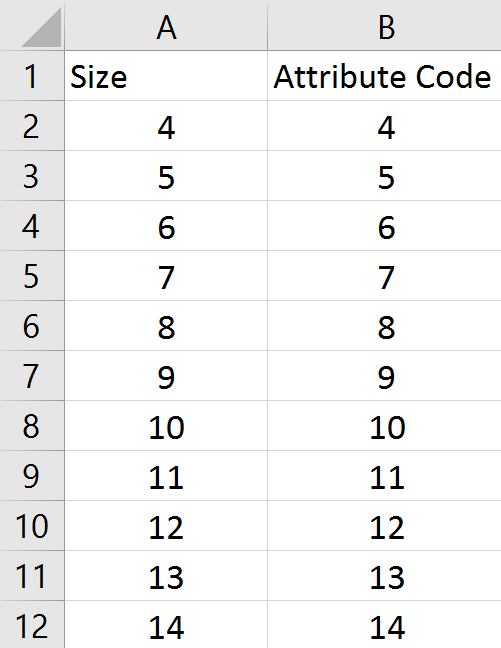
Spending some time coming up with a SKU naming strategy can help you:
- Keep track of your inventory levels.
- Communicate product information quickly and accurately between departments.
- Speed up your warehousing and order fulfillment operations.
You’ll also be able to make it easy for team members and staff to read and understand what each SKU represents.
In this post, we’ll look at some of the best practices used by companies to come up with SKU naming strategies. Before we begin, let’s quickly explain what SKUs are and why they’re important for your business.
What Are SKUs?
Stock keeping units (SKUs) are a combination of letters and numbers assigned to products and their variants that are primarily used to track inventory. If your products have attributes, you’ll have to create a SKU for each attribute combination.
There’s no standard way to create a SKU since their purpose is essentially to create a code that’s unique to your business.
Aside from SKUs there are two other commonly used types of codes that describe products:
UPC number (universal product code number) helps distributors and retailers keep track of inventory using point-of-sale software. It’s the 12-digit number you see below barcodes. Anyone with a barcode scanner can read the code and learn more about the product. It is a universal code meaning it’s not unique to any particular store. In other words, two stores selling the same product would assign them different SKUs but the same UPC number.
Serial numbers are unique for a given product and are generally used for electronic items. They’re used to keep track of who owns the product as well as its warranty information.
Here are some of the main reasons why it’s essential to spend some time thinking about your SKU naming strategy:
- Industry standard. Companies use SKUs as an industry standard to track their products throughout the supply chain. You’d find it very difficult to sell anything online without SKUs.
- Convey information quickly. SKUs enable everyone – sales team, warehouse staff, marketing team, and shipping partner – to easily understand the product’s attributes. It also allows them to convey product information quickly.
- Speed up and improve accuracy in warehousing procedures. SKUs make it easier for the warehouse staff to quickly locate, track, and reference items and monitor inventory levels. SKUs can also help you ensure the correct items are delivered to customers, thereby increasing customer satisfaction and improving your perfect order KPI.
Now that we have a basic understanding of SKUs, let’s take a look at how businesses go about creating SKUs.
How to Create and Name SKUs
There are no hard and fast rules when it comes to creating SKUs. Below, we’ll step through some widely-practiced SKU naming conventions to help you get you started.
Create a Format
Start by establishing a standard format for naming SKUs. Use a combination of letters and numbers to create your SKUs and decide on the order in which you’ll arrange product features. These might be the brand name, size, color, or item type. Best practices indicate that you should only include the most standout product features in SKU names. For instance, your standard SKU format might be:
Name of manufacturer, color of the product variant, size
So, for a blue Under Armour shoe in size 10, the SKU might be UDA-BL-10.
By following a pre-decided SKU naming format, you’ll be able to create SKUs for any new products your company starts selling.
Establish a Coding System
The next step is to come up with a list of attribute codes to identify different aspects in your SKU names such as brand names, sizes, types, and colors.
This can be done in spreadsheet software (such as Excel or Google Sheets) by merely mapping the attribute name to the attribute code. For instance, here’s how you can do this for brand names:
Similarly, you can do the same for other attributes like colors:
And sizes:
The key benefit of establishing a list of standardized attribute codes for SKU naming is that everyone on your team will be following the same key when assigning SKU names.
SKU Naming Best Practices
Here are some of the main SKU naming conventions and best practices used by companies all across the world.
#1: Ensure It’s Easy to Understand
SKU names should be simple, straightforward, and self-explanatory. This helps different departments within your company – such as operations, logistics, customer support staff, and the sales – efficiently understand exactly which product the SKU refers.
Your SKU naming should also enable team members to easily understand each SKU section. Start with the color, size, category, and seasonal variations and include them in your SKU name formats. You can use numbers to represent product sizes and letters to denote colors and material of products.
For example,
2019 Winter Collection, Jackets, Medium, Purple = WC-JT-MD-PP
2019 Winter Collection, Jackets, Medium, Yellow = WC-JT-MD-YL
2019 Winter Collection, Jackets, Medium, Blue = WC-JT-MD-BL
Pro tip: Try not to use numbers to denote colors as this can be pretty confusing and difficult to memorize. For example, 1 for blue or 2 for green.
#2: Arrange Words Based on Importance
Consider arranging SKU variables in the order of their importance. One way to do this is by looking at the products’ description and identifying the key attributes that stand out most. Depending on the types of products you sell, these might include the brand name, model, color, or warranty information.
Place the attributes that are most significant or constant (like brand name or model) at the beginning of the SKU section. Assign variable product attributes (like size and color) towards the end of the SKU section.
For example,
Holiday Treats, Chocolate bar, Small, Sugar-free = HT-CC-SMA-SF
Holiday Treats, Chocolate bar, Medium, Sugar-free = HT-CC-MDM-SF
Holiday Treats, Chocolate bar, Large, Sugar-free = HT-CC-LRG-SF
The first part of the SKU section defines the edition and the product, while the second part narrows the description down to the size and type.
#3: Avoid Using Letters That May Look Like Special Characters
Another thing to keep in mind is that some letters and numbers look similar, which might be confusing for team members. Additionally, you should also avoid using special characters. Here are some examples:
- I (uppercase i) and l (lowercase L) look the same.
- The number 0 and letter O appear to be similar in most fonts.
- Special characters like the forward slash “/” will be treated as a data separator in Excel.
- Symbols like @, >, <, *, don’t always have a standard, clear meaning.
Instead, you should always stick to using numbers and letters to name your SKUs as depicted in the following example:
Summer Edition, Running shoes, Size 10, Blue = SE-RS-10-BL
Summer Edition, Running shoes, Size 11, Blue = SE-RS-11-BL
Summer Edition, Running shoes, Size 12, Blue = SE-RS-12-BL
#4: Avoid Starting SKU Names With Zero
Another reason to not use the number 0 to start your SKUs is that some data storing tools disregard them altogether. For example, entering 04563 in Excel would actually store 4563. As a rule of thumb, avoid using zeros to start your SKU naming to stay clear of data storage issues.
In fact, we recommend that you avoid starting your SKU names with numbers altogether and instead go with letters. This way, the reader will instantly recognize SKUs in spreadsheets.
For example,
Home Decor, Scented Candles, Small, Pack of 4 = HD-SC-SML-PO4
Home Decor, Scented Candles, Small, Pack of 8 = HD-SC-SML-PO8
Home Decor, Scented Candles, Small, Pack of 12 = HD-SC-SML-PO12
#5: Don’t Use Manufacturer Numbers
Whether you run an online store or a brick-and-mortar store, you should avoid incorporating the manufacturer’s SKUs in your own SKU names. The reason is pretty simple: using manufacturer SKU names can be confusing if you sell products produced by different companies.
Manufacturers already put a lot of thought into making their SKUs unique and self-explanatory. You need to come up with your own format for creating SKUs.
For instance, if the manufacturer’s SKU name is:
Sports Bra, Red, Band Size 36 = SBR-RD-BS36
You can make your SKU name:
Sports Bra, Red, Band Size 36, Rib Cage 15 to 27 = SBR-RD-BS36-RC1527
#6: Keep SKU Names Simple
Lastly, don’t stuff your SKU names with too much information. Keeping things simple allows you to make it easier for team members to memorize SKU naming conventions and quickly identify the correct product variant.
A 30-digit SKU name, for example, is bound to contain a lot of details about your product but it will also slow down your order fulfillment team and potentially cause mix-ups in the picking, packing, and shipping processes. You’d be better off not including every tiny bit of information about each product variation in its SKU name.
Try to include only 2-3 product aspects in your SKU names. For example:
Headphones, Golden, Bluetooth wireless = HDPH-GD-BTWS
Headphones, Purple, Bluetooth wireless = HDPH-PP-BTWS
Headphones, White, Bluetooth wireless = HDPH-WT-BTWS
However, if you absolutely must store more information in SKU names (for example, if you have to distinguish between five different manufacturers), assign each manufacturer a number (from 1-6) instead of using letters to denote their names.
For example,
Kettle, White, Electric, Kobys = KTL-WH-ET-1
Kettle, Blue, Electric, Tango = KTL-BL-ET-6
Kettle, Blue, Electric, Ningbo = KTL-BL-ET-4
Conclusion
When it comes to creating a SKU naming convention for your business, consistency is key. With the right SKU format, you’ll be able to better track inventory and speed up warehousing activities.
We shared some of the best practices and conventions for creating SKUs and, hopefully, you’re in a good position now to take the next steps.
What are some of the main product attributes you include in your SKU names? Are you including too many attributes? Let us know by commenting below.
FAQ
How do you handle SKU naming for products with multiple variants?
For products with multiple variants beyond color and size, such as material or function, SKU naming should incorporate concise codes for each variant. Establish a systematic approach to encode these additional attributes while ensuring the SKU remains readable and manageable. Consistency across product lines helps maintain clarity.
What strategies are recommended for updating SKUs when a product is upgraded or has a new version?
When a product undergoes significant changes or upgrades, it’s important to integrate this into the SKU without causing confusion. One strategy is to add a version number or year to the SKU to denote the upgrade while maintaining the original base code for product identification.
How do SKU naming conventions impact SEO and online visibility for ecommerce products?
Effective SKU naming can positively impact SEO by including key product attributes that potential customers might search for. Clear and descriptive SKUs can enhance product page discoverability online, making it easier for search engines to index and for customers to find relevant products.










